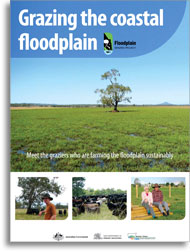
Floodplain grazing project
 Coastal floodplains are extensively used for grazing, but until recently, little was known about the feed quality of native wet pasture species.
Coastal floodplains are extensively used for grazing, but until recently, little was known about the feed quality of native wet pasture species.
Floodplain wetlands were largely drained over the last century and have since been used to grow introduced pasture varieties. Drainage brought many positive benefits, but also introduced some negative impacts on the environment such as acid sulfate soils, poor water quality and fewer wetland birds, plants and fish. Now there is an expectation that farmers will not only produce agricultural products, but also do it in a way that minimises impact on natural resources.
Wet pasture management involves the controlled retention of water in formerly drained swamps to enhance the growth of native wet pasture. Excessive surface water is still removed, but groundwater levels are kept intact to foster vigorous wet pasture establishment and growth.
These native swamp grasses have been shown to offer improved nutritional content, high protein levels and digestibility for stock. Species such as water couch provide good to high quality feed and yields can exceed 10 tonnes of dry matter per hectare.
Now that our knowledge has improved, farmers are in the position to meet the challenge of farming the floodplain both sustainably and profitably.
The information sheets are available for download below.
| Title | Details |
|---|---|
| Establishing a Wet Pasture System | PDF, 186.7 KB |
| Black water | PDF, 289.3 KB |
| Feed quality of coastal wet pastures | PDF, 600.0 KB |
| Grazing the coastal floodplain case studies | PDF, 1.0 MB |
| Water couch | PDF, 196.3 KB |
| Water couch growth and productivity | PDF, 243.9 KB |

